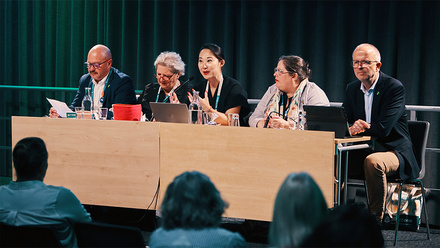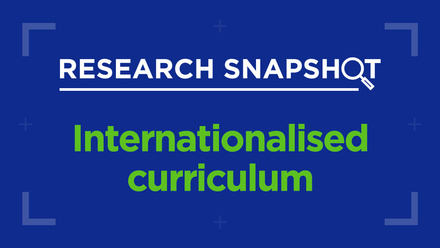Getting practical about vocational education

Often overlooked in discussions about the value of international experience are the students who will go on to work in trade or service industry jobs. Currently workers in these sectors are feeling the full brunt of the economic impact of the COVID-19 pandemic. Shining a light on a possible path forward, this ongoing initiative in the Netherlands illustrates how we can approach incorporating internationalisation in vocational education moving forward.
Upper-secondary vocational education in the Netherlands generally prepares students for the regional labour market. The majority of enrolled students at a VET institution come from the region where they are studying, and currently most of them stay in that region. With this focus on the local community and the regional job market, one might ask: why internationalisation?
VET institutions in the Netherlands have a threefold responsibility to prepare students for:
- their role in society (citizenship),
- participation in the (often regional) labour market, and
- lifelong learning
As globalisation and the changing global economy impacts all societies, affecting most (if not all) jobs and necessitating lifelong learning, internationalisation of the VET sector has also gained attention in recent years. In 2016, the Netherlands Board of Education advised the Ministry of Education that all young people should become internationally competent, including at the VET level. This has resulted in increased attention for internationalisation in VET education. The desire to reach all students with internationalisation has led two VET institutions in the Netherlands – ROC Mondriaan and ROC van Twente – to initiate something called a practoraat on internationalisation.
What is a practoraat?
A practoraat is a recent innovation in the Dutch vocational education and training sector. It is a sort of expertise platform for a thematic area of focus: examples of such focus areas are as wide-ranging as cybersecurity, citizenship education, personalised learning and aviation. Some would compare a practoraat to a research group; others describe it as a ‘skills lab’ or ‘discovery centre’. From my perspective, the main aim of a practoraat is to innovate in education based on practice-based research. This is done by conducting research within the setting of the VET institution, by experimenting in the educational practices at the institution and by collaborating (co-creating) with the labour market.
The main aim of a practoraat is to innovate in education based on practice-based research
The way a practoraat is operationalised differs from institution to institution. As my practoraat on internationalisation spans two institutions, I can describe two examples. In one of the participating institutions, I am positioned at a central level as part of the policy department. As there are 27 schools at this institution, each with a director and operating with a high degree of independence, this positioning makes the practoraat accessible to all schools and programmes. At the other institution, the practoraat is closely linked to four clusters of programmes, each led by a managing director. In addition, there are four teacher-researchers who are each linked to one of these clusters. This way, the link to educational practice is firmly embedded. Practoraten also have many tasks, and in each institution the main focus might differ, from more focus on bringing in the outside world, to experimenting with students, to mainly doing research.
Why a practoraat on internationalisation?
When talking about internationalisation in VET, many colleagues initially think of students doing an internship abroad or groups of students going on a study visit or exchange for a limited amount of time. Similar to the case at research universities and universities of applied sciences, only a limited number of students have the opportunity to actually participate in such mobility experiences.
All students live, work and study in a region increasingly connected with the rest of the world
At the same time, it is a fact that all students live, work and study in a region increasingly connected with the rest of the world. Nurses will have to deal with a mixed patient population, traders and merchants will most likely do business with companies in other countries, construction workers are likely to collaborate with construction workers from other countries, or might be involved in a project by a Dutch company carried out abroad. There are many situations imaginable in which things like intercultural competences, knowledge of international rules and regulations and (intercultural) communication skills are at least an advantageous asset, if not an important or even an essential skill.
Thus managers at these two VET institutions, in cooperation with their policy advisors on internationalisation, initiated a practoraat to stimulate internationalisation for all at these two schools. The questions the practoraat helps to answer are: How can we prepare all our students to work, live and study in this diverse society and internationally-oriented education and labour market? What do students need to learn to ‘succeed’ in the world of today and tomorrow? How can we prepare our students to successfully live, work and study in today’s interconnected world? How can VET institutions successfully integrate internationalisation in the curricula? What can we do in our curricula to make it more internationalised? What can we expect from our staff?
Slowly but surely, the practoraat is finding its focus based on the existing literature as well as discussions and interviews. Moving forward, our research within the practoraat internationalisation will focus on:
1) The current and future demands of the diverse society and internationally-oriented education and labour market. When we have a general overview based on a review of the literature, we will investigate what this means for various programmes within different domains. In other words, we will explore what different stakeholders say about the necessary international competences for employees within their industries (in the region).
2) The desired and realised learning outcomes of certain internationalisation activities at the two participating VET institutions. We would like to develop a sort of inspiration toolbox. This toolbox can contain many examples of activities, including insights into the implementation of these activities within particular contexts. Closely linked to this is a desire to inspire staff to think about the desired impact and outcomes of internationalisation in general, and of specific internationalisation activities in particular. We think that this change in approach is a necessary step towards integrating internationalisation in the curricula.
The practoraat internationalisation thus wishes to contribute to the intentional integration of internationalisation in various study programmes. While we have no authority to change study programmes, we can certainly contribute by sharing our insights and inspiring colleagues. It would be a great pleasure if we succeed in sensitising staff to the importance of internationalisation in preparing students for their future and in supporting staff (especially the teams of teachers) to develop internationalised educational programmes.






